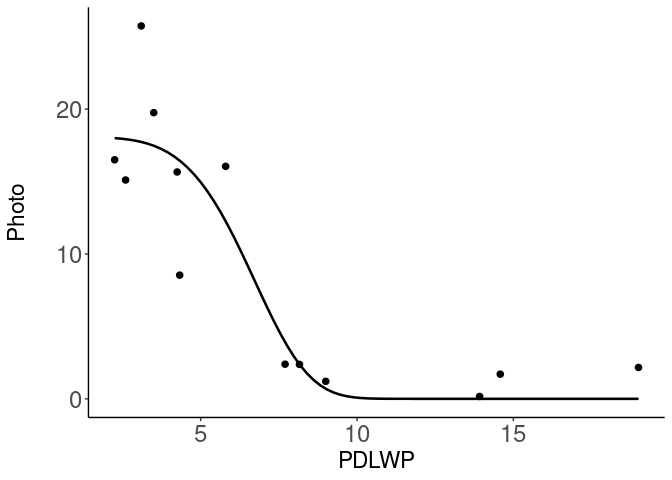Hello,
I would like to plot two 3-parameter Weibull curves in a single plot. I know how to plot individual curves using nls2 and ggplot2. My problem is, that I don’t know how to plot two curves from two data groups in the same plot. In the example below I would like to define the Weibull parameters for the data points belonging to the group “dip1” (in column “geno”) and for the group “dip2” with the “nls(…) command. I then would like to plot two individual curves using ggplot2 in the same plot. In this small example, my X-axis points are called “PDLWP” and my Y-axis points are called “Photo”. I already wrote some code that plots a single Weibull curve using the combined data sets of dip1 and dip2 points. Could anybody help me to plot two curves one for dip1 and one for dip2? Thank you very much for your help
dta<-structure(list(ploidy = c("dip", "dip", "dip", "dip", "dip", "dip", "dip", "dip", "dip", "dip", "dip", "dip", "dip", "dip", "dip", "dip", "dip", "dip", "dip", "dip", "dip", "dip", "dip", "dip", "dip", "dip"), geno = c("dip1", "dip1", "dip1", "dip1", "dip1", "dip1", "dip1", "dip1", "dip1", "dip1", "dip1", "dip1", "dip1", "dip2", "dip2", "dip2", "dip2", "dip2", "dip2", "dip2", "dip2", "dip2", "dip2", "dip2", "dip2", "dip2"), Photo = c(5.429849559, 15.56020359, 17.11031242, 3.898958096, 2.170068415, 9.635005028, 19.71198385, 0.621534066, 15.31952903, 12.05323573, 0.268807378, 15.12996082, 8.24572244, 25.73923074, 15.10455617, 16.04850297, 2.390612635, 2.164994013, 19.75451088, 15.65863235, 1.206895049, 2.374035234, 16.50051398, 0.16242929, 8.537029628, 1.700498836 ), PDLWP = c(3.1, 2.6, 5.8, 7.7, 19, 3.5, 4.25, 9, 8.16, 2.25, 13.92, 4.33, 14.58, 3.1, 2.6, 5.8, 7.7, 19, 3.5, 4.25, 9, 8.16, 2.25, 13.92, 4.33, 14.58)), class = "data.frame", row.names = c(NA, -26L))
dta
#> ploidy geno Photo PDLWP
#> 1 dip dip1 5.4298496 3.10
#> 2 dip dip1 15.5602036 2.60
#> 3 dip dip1 17.1103124 5.80
#> 4 dip dip1 3.8989581 7.70
#> 5 dip dip1 2.1700684 19.00
#> 6 dip dip1 9.6350050 3.50
#> 7 dip dip1 19.7119838 4.25
#> 8 dip dip1 0.6215341 9.00
#> 9 dip dip1 15.3195290 8.16
#> 10 dip dip1 12.0532357 2.25
#> 11 dip dip1 0.2688074 13.92
#> 12 dip dip1 15.1299608 4.33
#> 13 dip dip1 8.2457224 14.58
#> 14 dip dip2 25.7392307 3.10
#> 15 dip dip2 15.1045562 2.60
#> 16 dip dip2 16.0485030 5.80
#> 17 dip dip2 2.3906126 7.70
#> 18 dip dip2 2.1649940 19.00
#> 19 dip dip2 19.7545109 3.50
#> 20 dip dip2 15.6586323 4.25
#> 21 dip dip2 1.2068950 9.00
#> 22 dip dip2 2.3740352 8.16
#> 23 dip dip2 16.5005140 2.25
#> 24 dip dip2 0.1624293 13.92
#> 25 dip dip2 8.5370296 4.33
#> 26 dip dip2 1.7004988 14.58
#Load packages
library(ggplot2)
library(nlme)
library(nls2)
library(proto)
#model structure: 3 parameter Weibull
#y ~ m*exp(-1*(x/b)^c)
#Define the outer boundaries to search for initial values
grd <- data.frame(m=c(10,30),
b=c(0,10),
c=c(0,10))
#Brute-force initial values
fit <- nls2(Photo ~ m*exp(-1*(PDLWP/b)^c),
data=dta,
start = grd,
algorithm = "brute-force",
control=list(maxiter=10000))
fit
#> Nonlinear regression model
#> model: Photo ~ m * exp(-1 * (PDLWP/b)^c)
#> data: dta
#> m b c
#> 14.762 8.095 7.619
#> residual sum-of-squares: 583.4
#>
#> Number of iterations to convergence: 10648
#> Achieved convergence tolerance: NA
finalfit <- nls(Photo ~ m*exp(-1*(PDLWP/b)^c), data=dta, start=as.list(coef(fit)))
# Plot in ggplot
example<-ggplot(dta, aes(x=PDLWP,y=Photo)) + geom_point(size=2)+
theme_classic()+
theme(legend.position="none")+
theme(axis.text=element_text(size=18),
axis.title=element_text(size=17,),axis.title.y=element_text(margin=margin(0,20,0,0)))+
stat_smooth(method = "nls", formula = y ~ m*exp(-1*(x/b)^c), method.args=list(start=as.list(coef(finalfit))), size = 0.9, se = FALSE, colour = "black")
example

Created on 2021-03-03 by the reprex package (v1.0.0)



